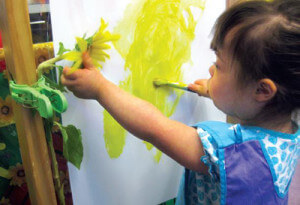Art therapy has proven to be a successful form of treatment for special education students and kids with other behavioral, emotional or psychological issues. This type of therapy can be considered a psychotherapeutic service. It allows kids to express themselves in non-verbal ways through the use of art tools and supplies. This form of expression can tell a counselor many things. In fact, it provides a way for the child to communicate things they simply cannot say in words.
About Art Therapy
 Art therapists are the professionals who guide the child in this particular mode of therapy. Though it can be used with people of all ages, children in special education services will be the primary group addressed here. Children are encouraged to express their feelings through the art that they create in their session. In addition, they have the chance to learn social skills, gain cognitive growth, obtain coping mechanisms through the resolution of frustration and practice sensorimotor skills such as sensory stimulation and hand-eye coordination. In addition, practical skills are learned such as how to find and put away art supplies, ways in which to utilize certain tools and the importance of putting away their supplies and cleaning themselves up.
Art therapists are the professionals who guide the child in this particular mode of therapy. Though it can be used with people of all ages, children in special education services will be the primary group addressed here. Children are encouraged to express their feelings through the art that they create in their session. In addition, they have the chance to learn social skills, gain cognitive growth, obtain coping mechanisms through the resolution of frustration and practice sensorimotor skills such as sensory stimulation and hand-eye coordination. In addition, practical skills are learned such as how to find and put away art supplies, ways in which to utilize certain tools and the importance of putting away their supplies and cleaning themselves up.
The kinds of artwork done by students in this type of therapeutic situation are quite varied. They may include making collages, drawing pictures. painting murals, crafting puppets and creating sculptures, among a myriad of other activities. All of these are ways for the child to express their feelings and to provide information indirectly to the therapist.
Benefits of Artistic Therapy
This approach to therapeutic intervention is a very useful tool in dealing with various disabilities, special needs and behavioral issues. Through this modality, students can often achieve a closer balance in brain hemispheres. An imbalance is believed to affect things like learning disabilities, depression, anger and perception. Adding such creative therapy to other forms of counseling can aid in the learning of coping skills that are often lacking in conditions like Attention Deficit/Hyper Activity Disorder, Autism Spectrum Disorder and Conduct Disorder.
Artistic therapies can lead to enhanced self-confidence and self-worth. Populations such as those with mental retardation who are often over-reliant on adult and authority figures for guidance and behavioral clues have been found to gain more realistic perspectives on the world and improved self-expression through their artistic endeavors combined with therapeutic counseling.
In general, this type of expressive intervention can lead to a world of behavioral and emotional benefits. Children who are resistant to authority are often more willing to follow instructions and put their supplies in their proper place when the incentive of being able to express themselves through art is available to them. Trust and close bonds are achieved with the art therapist, as well as with peers, through the use of guided artistic activities.
As you can see there are a number of ways in which art is used in combination with various therapies to help children dealing with a multitude of issues. Art therapy is a proven and worthwhile tool in working to enhance the lives of special education students.



